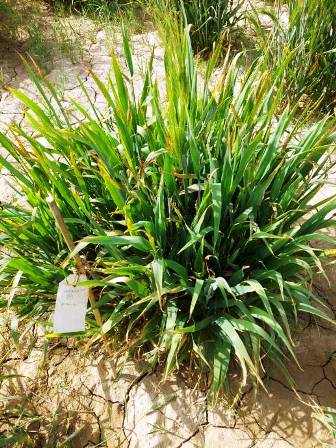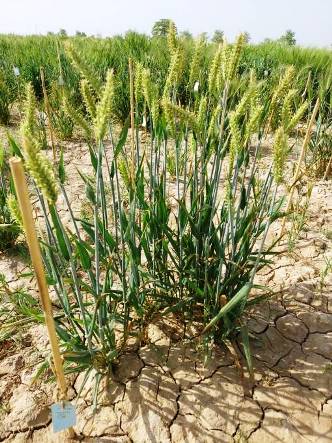भारत में नमक सहिष्णु जौ किस्म के विकास में प्रगति
Barley (Hordeum vulgare) is the fourth most important crop of the world after rice, wheat and maize with respect to area and production. It is known as a hardy crop compared to wheat, rice and maize and more suitable for areas with limited water (drought or less water availability), nutrients and soil health (salinity/alkalinity).
The geographical range in which barley can be grown as a staple crop is quite wide and therefore it is grown from sub-tropical and arid plains to hills and cold desert ecologies under rainfed or limited irrigated conditions around the world except tropics. It is an ancient crop domesticated in pre-historic era with proposed centres of origin in Near East (Fertile Crescent) and South East Asia (China, Tibet and Nepal).
During the course of evolution, barley has dichotomised in six-row and two-row types where six-row type barley is used mainly as feed and food while the two-row type is utilized for malting purposes. The preferred six row type barley used for food purposes is the husk less (naked) barley where the grain is free threshing similar to wheat i.e., the outer husk gets removed during the course of threshing and the grains do not require a mechanical processing (pearling) for removal of tightly adhered husk like hulled barley before its utilization to make food items.
In India, around 70% of the barley produced is used for feed or food purposes, which also includes the husk less barley cultivated in hills and tribal areas. The origin of husk less barley, used mainly for food purposes, has been attributed to western and central Himalayan regions. The consumption of barley finds a mention in the Vedic texts and therefore it is widely held that it has been used a main staple cereal in India from pre-historic times.
Apart from food, barley has been utilized for vivid purposes mainly being in animal feed and malting. The malt is used for production of beer, nutraceuticals, vinegar, diuretic syrups and whisky. Over the years, the world has grown nutritionally and health conscious and, in this context, barley has found a new niche role as a “functional food” because of the presence high amount of soluble and non-soluble fibre, having medicinal properties of lowering the cholesterol and reduction of body weight.
These confer barley medicinal properties specific to modern life style diseases such as heart ailments, diabetes, high blood pressure etc. Because of its high-quality protein content and concentration (11.5%) and carbohydrate (74%), fat (1.3%) and crude fibre (3.9%) composition, it is also being used in commercial nutritional/ energy supplements. Therefore, it can be implied that barley as a hardy and nutritional cereal crop, has huge potential in climate change and high input commercial agricultural scenario contributing to soil salinity.
Soil and weather requirements for barley
The barley crop requires cool weather (20-25o temperature) during growth and warm weather during maturity similar to wheat. It is a rabi season crop and commonly grown as the main cereal where cultivation of wheat is not possible mainly because of limited water availability or poor soil fertility levels.
The Rajasthan state of India, therefore, accounts for approximately half (40-50%) of the total barley production of the country, followed by Uttar Pradesh (25-30%). Barley can be grown on a range of soils, though sandy loam soils with neutral pH and low salt concentration are the most preferred ones.
The Northern part of country comprising of the Indo-Gangetic plains have this kind of soil, however wheat is the main rabi season crop here. Wheat grows very well in well drained loams but the productivity declines in sandy arid soils with high salt concentration. However, barley is one of the most salt tolerant and therefore a preferred crop in areas having such soils such as the desert, arid and semi-arid regions and coastal areas.
In a country like India with a large chunk of inferior soils such as saline/alkaline in arid, semi-arid and coastal areas, barley could be a crop of not only food and nutritional security but also of generating foreign exchange through export of quality/functional food products and superior malt types.
Importance of genetic tolerance to salinity
The total arable land is shrinking in India because of rampant population explosion and change of land use from agricultural to urban landscaping. Under these circumstances, the mainstream crops such as wheat are being pushed to waste lands characterised by high salt concentration resulting in to low productivity because of high sensitivity of these crops to soil salinity.
The salt affected area in the country amounts approximately 6.74 million hectares. Not only this, nearly about 0.67 million hectares of land is turning into salt affected each year and according to one estimate by the mid of this century, half of the arable land might be salt affected to some degree.
Under such circumstances, the importance of barley as a crop for such areas should not be considered as over emphasised, because of the high cost involved in chemical reclamation of such soils and that too with a limited success. Moreover, the associated environmental cost of such interventions is also high.
The inbuilt genetic tolerance in barley when pyramided in varieties with superior agronomic traits can be an economically and environmentally better alternative as only the seed of tolerant variety is the sole input that needs to be delivered to the farmer.
As far as cereal crops are concerned, barley is the most salt tolerant crop as it can tolerate 250 mM NaCl concentration. This concentration of salt is equivalent to 40% seawater. Moreover, the pH range in which barley crop can be successfully taken ranges from 6 - 8 and it suffers yield loss at a pH exceeding 9. Among different types of barley, the hulled barley is more tolerant to saline conditions as compared to the huskless types.
The breeding of soil salinity tolerant barley varieties is a challenging endeavour because the genetics of the tolerance is complex as the trait is controlled by multiple genes. The development of varieties requires field screening of a large number of barley genotypes under salt stress.
This is a challenging preposition because the natural soil salinity is highly uneven in the field and the screening methods, thus, might involve high experimental error.
In spite of the challenges mentioned above, the Indian Barley Improvement Programme has identified salt tolerant source genotypes and has successfully developed barley varieties with superior performance in salt affected soils. 

Characterization of exotic barley genotypes for soil salinity stress under field conditions
Table : Salt tolerant barley varieties released in India
|
S. No |
Variety |
Cross/ Parentage |
Year of release |
Released by |
Specific area of adaptation |
Salient features |
Developed at |
Avg. qha |
Pot. q/ha. |
|
1 |
AZAD (K 125) |
K12/K19 |
1975 |
SVRC |
U.P. for rainfed and saline-alkaline conditions |
Also identified for rainfed cultivation and good for fodder |
CSAUA&T, Kanpur |
25 |
35 |
|
2 |
Bilara 2 |
RS17/C251 |
1978 |
SVRC |
Rajasthan for saline-alkaline soils |
Medium tall, Six-row hulled barley suitable for saline- sodic soils, yellow good bold grains. |
ARS, SKRAU, Durgapura |
20 |
25 |
|
3 |
RD 2552 |
RD2035/DL472 |
1999 |
CVRC |
NWPZ, NEPZ for irrigated timely sown as well as for saline soils |
Six-row feed barley with high grain yield under normal and saline soils, resistant to yellow rusts and leaf blights |
ARS, SKRAU, Durgapura |
44.06(NWP), 38.37 (NEP |
61.0, 45.98 |
|
4 |
NDB 1173 |
BYTLRA3 (94-95) / NDB217 |
2005 |
CVRC |
NWPZ and NEPZ for saline soils |
Hulled barley for saline-alkaline soils of NWPZ and NEPZ, high grain yield and resistant to leaf blights |
NDUA&T, Faizabad |
35.2 |
46.2 |
|
5 |
RD 2794 |
RD2035/RD2683 |
2013 |
CVRC |
Irrigated timely sown in NWPZ and NEPZ under saline-sodic soils |
Six-row hulled barley for saline-alkaline soils of NWPZ and NEPZ, high grain yield and resistant to rusts and leaf blights |
ARS, SKRAU, Durgapura |
29.9 |
43.3 |
|
6 |
NDB 1445 |
NDB940/Ratna |
2013 |
SVRC |
Irrigated timely sown in UP for saline soils |
Six-row hulled barley for saline-alkaline soils of UP, high grain yield and resistant to rusts and leaf blights with bold grains |
NDUA&T, Faizabad |
32 |
38 |
|
7 |
RD2907 |
RD103/RD2518//RD2592 |
2018 |
CVRC |
Salinity conditions in NWPZ & NEPZ |
Six rowed feed barley, timely sown irrigated condition in saline/alkaline areas of NWPZ&NEPZ |
RARI Durgapura |
35.25 |
53.62 |
|
8 |
KB1425 |
K508/NNDB1295 |
2021 |
SVRC |
Irrigated timely sown, in saline-sodic soils in Uttar Pradesh |
Six row hulled barley for feed purposes |
CSAUA&T Kanpur |
33.1 |
47.3 |
NWPZ= Punjab, Haryana, Western UP, Delhi and Rajasthan (Except Kota and Udaipur regions), NEPZ = Eastern Uttar Pradesh, Bihar and West Bengal, CVRC= Central Varietal release Committee for zonal release, SVRC= State Varietal Release Committee
Authors
S.K. Bishnoi1, Madhu Patial2, Dinesh Kumar1 and RPS Verma1*
1ICAR-Indian Institute of Wheat and Barley Research, Karnal
2ICAR-Indian Agricultural Research Institute, Regional Station, Shimla
Email: *
